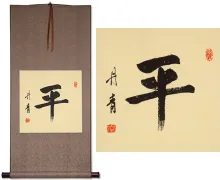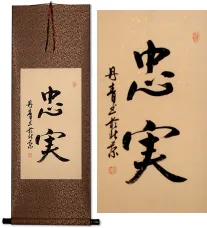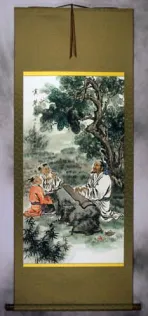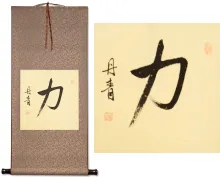Many custom options...
And formats...

Not what you want?
Try other similar-meaning words, fewer words, or just one word.
Feel free to email me with your request. If it's easy, I'll translate it for free and add it to this database of calligraphy for you.
Supreme Being in Chinese / Japanese...
Buy a Supreme Being calligraphy wall scroll here!
Siddhartha
悉達多 is the name Siddhartha (as in Siddhartha Gautama), the personal name for Śākyamuni.
This same Buddha is also known as “Shakyamuni Gautama,” “Gotama Buddha,” or “Tathagata.”
Siddhartha Gautama was a spiritual teacher in the northern region of the Indian subcontinent who founded Buddhism. He is generally seen by Buddhists as the Supreme Buddha (Sammāsambuddha) of known human history.
The actual meaning of this name in Chinese is the realization of all aims, or simply being prosperous.
This name is sometimes romanized from the original Sanskrit or Pali as Siddhattha (from Siddhattha Gotama), Siddharth, Siddhārtha, or Sarvāthasiddha.
Siddhārtha or Sarvāthasiddha can also be written as 悉達, 悉多, 悉多頞他, or 悉陀.
This in-stock artwork might be what you are looking for, and ships right away...
Gallery Price: $300.00
Your Price: $109.88
Gallery Price: $65.00
Your Price: $39.88
Gallery Price: $90.00
Your Price: $49.88
Gallery Price: $286.00
Your Price: $158.88
Gallery Price: $83.00
Your Price: $45.88
Gallery Price: $65.00
Your Price: $39.77
Not the results for supreme being that you were looking for?
Below are some entries from our dictionary that may match your supreme being search...
| Characters If shown, 2nd row is Simp. Chinese |
Pronunciation Romanization |
Simple Dictionary Definition |
梵 see styles |
fàn fan4 fan bon ぼん |
abbr. for 梵教[Fan4 jiao4] Brahmanism; abbr. for Sanskrit 梵語|梵语[Fan4 yu3] or 梵文[Fan4 wen2]; abbr. for 梵蒂岡|梵蒂冈[Fan4 di4 gang1], the Vatican (1) Brahman (ultimate reality of the universe in Hinduism); Brahma; (2) Brahma (Hindu creator god); (3) (abbreviation) (See 梵語) Sanskrit; (given name) Bon Brahman (from roots bṛh, vṛh, connected with bṛṃh, "religious devotion," "prayer," "a sacred text," or mantra, "the mystic syllable om"; "sacred learning," "the religious life," "the Supreme Being regarded as impersonal," "the Absolute," "the priestly or sacerdotal class," etc. M.W. Translit. |
上天 see styles |
shàng tiān shang4 tian1 shang t`ien shang tien jouten / joten じょうてん |
Heaven; Providence; God; the sky above; to fly skywards; (euphemism) to die; to pass away; the previous day (or days) (1) (See 下土) sky; the heavens; (2) God; the Lord; the Creator; the Supreme Being; (3) ascension (into heaven); (surname) Jōten to ascend to heaven |
四重 see styles |
sì zhòng si4 zhong4 ssu chung shijuu / shiju しじゅう |
(noun - becomes adjective with の) fourfold (四重禁) The four grave prohibitions, or sins, 四重罪 pārājikas: killing, stealing, carnality, lying. Also four of the esoteric sect, i. e. discarding the truth, discarding the bodhi-mind, being mean or selfish in regard to the supreme law, injuring the living. |
大日 see styles |
dà rì da4 ri4 ta jih dainichi だいにち |
Mahavairocana (Tathagata); Great Sun; Supreme Buddha of Sino-Japanese esoteric Buddhism; (place-name, surname) Dainichi Vairocana, or Mahāvairocana 大日如來; 遍照如來; 摩訶毘盧遮那; 毘盧遮那; 大日覺王 The sun, "shining everywhere" The chief object of worship of the Shingon sect in Japan, "represented by the gigantic image in the temple at Nara." (Eliot.) There he is known as Dai-nichi-nyorai. He is counted as the first, and according to some, the origin of the five celestial Buddhas (dhyāni-buddhas, or jinas). He dwells quiescent in Arūpa-dhātu, the Heaven beyond form, and is the essence of wisdom (bodhi) and of absolute purity. Samantabhadra 普賢 is his dhyāni-bodhisattva. The 大日經 "teaches that Vairocana is the whole world, which is divided into Garbhadhātu (material) and Vajradhātu (indestructible), the two together forming Dharmadhātu. The manifestations of Vairocana's body to himself―that is, Buddhas and Bodhisattvas ―are represented symbolically by diagrams of several circles ". Eliot. In the 金剛界 or vajradhātu maṇḍala he is the center of the five groups. In the 胎藏界 or Garbhadhātu he is the center of the eight-leaf (lotus) court. His appearance, symbols, esoteric word, differ according to the two above distinctions. Generally he is considered as an embodiment of the Truth 法, both in the sense of dharmakāya 法身 and dharmaratna 法寳. Some hold Vairocana to be the dharmakāya of Śākyamuni 大日與釋迦同一佛 but the esoteric school denies this identity. Also known as 最高顯廣眼藏如來, the Tathagata who, in the highest, reveals the far-reaching treasure of his eye, i.e. the sun. 大日大聖不動明王 is described as one of his transformations. Also, a śramaņa of Kashmir (contemporary of Padma-saṃbhava); he is credited with introducing Buddhism into Khotan and being an incarnation of Mañjuśrī; the king Vijaya Saṃbhava built a monastery for him. |
文殊 see styles |
wén shū wen2 shu1 wen shu monju もんじゅ |
Manjushri, the Bodhisattva of keen awareness (Buddhist term) Manjushri; Manjusri; Bodhisattva that represents transcendent wisdom; (p,s,f) Monju (文殊師利) Mañjuśrī 滿殊尸利 -later 曼殊室利. 文殊 is also used for Mañjunātha, Mañjudeva, Mañjughoṣa, Mañjuṣvara, et al. T., hjamdpal; J., Monju. Origin unknown; presumably, like most Buddhas and bodhisattvas, an idealization of a particular quality, in his case of Wisdom. Mañju is beautiful, Śrī; good fortune, virtue, majesty, lord, an epithet of a god. Six definitions are obtained from various scriptures: 妙首 (or 頭 ) wonderful or beautiful) head; 普首 universal head; 濡首 glossy head (probably a transliteration); 敬首 revered head; 妙德 wonderful virtue (or power); 妙吉祥 wonderfully auspicious; the last is a later translation in the 西域記. As guardian of wisdom 智慧 he is often placed on Śākyamuni's left, with 普顯 on the right as guardian of law 理, the latter holding the Law, the former the wisdom or exposition of it; formerly they held the reverse positions. He is often represented with five curls or waves to his hair indicating the 五智 q. v. or the five peaks; his hand holds the sword of wisdom and he sits on a lion emblematic of its stern majesty: but he has other forms. He is represented as a youth, i. e. eternal youth. His present abode is given as east of the universe, known as 淸涼山 clear and cool mountain, or a region 寶住 precious abode, or Abode of Treasures, or 寶氏 from which he derives one of his titles, 寶相如來. One of his dhāraṇīs prophesies China as his post-nirvāṇa realm. In past incarnations he is described as being the parent of many Buddhas and as having assisted the Buddha into existence; his title was 龍種上佛 the supreme Buddha of the nāgas, also 大身佛 or 神仙佛; now his title is 歡喜藏摩尼寶精佛 The spiritual Buddha who joyfully cares for the jewel: and his future title is to be 普現佛 Buddha universally revealed. In the 序品 Introductory Chapter of the Lotus Sutra he is also described as the ninth predecessor or Buddha-ancestor of Śākyamuni. He is looked on as the chief of the Bodhisattvas and represents them, as the chief disciple of the Buddha, or as his son 法王子. Hīnayāna counts Śāriputra as the wisest of the disciples, Mahāyāna gives Mañjuśrī the chief place, hence he is also styled 覺母 mother, or begetter of understanding. He is shown riding on either a lion or a peacock, or sitting on a white lotus; often he holds a book, emblem of wisdom, or a blue lotus; in certain rooms of a monastery he is shown as a monk; and he appears in military array as defender of the faith. His signs, magic words, and so on, are found in various sutras. His most famous centre in China is Wu-tai shan in Shansi. where he is the object of pilgrimages, especially of Mongols. The legends about him are many. He takes the place in Buddhism of Viśvakarman as Vulcan, or architect, of the universe. He is one of the eight Dhyāni-bodhisattvas, and sometimes has the image of Akṣobhya in his crown. He was mentioned in China as early as the fourth century and in the Lotus Sutra he frequently appears, especially as the converter of the daughter of the Dragon-king of the Ocean. He has five messengers 五使者 and eight youths 八童子 attending on him. His hall in the Garbhadhātu maṇḍala is the seventh, in which his group numbers twenty-five. His position is northeast. There are numerous sutras and other works with his name as title, e. g. 文殊師利問菩提經 Gayaśīrṣa sūtra, tr. by Kumārajīva 384-417: and its 論 or .Tīkā of Vasubandhu, tr. by Bodhiruci 535. see list in B. N. |
等妙 see styles |
děng miào deng3 miao4 teng miao tō myō |
The two supreme forms of Buddha-enlightenment 等覺 and 妙覺, being the 51st and 52nd stages of the Mahāyāna 階位. A Buddha is known as等妙覺王, king of these two forms of universal and supernatural illumination. |
轉輪 转轮 see styles |
zhuàn lún zhuan4 lun2 chuan lun tenrin |
rotating disk; wheel; rotor; cycle of reincarnation in Buddhism cakravartī, "a ruler the wheels of whose chariot roll everywhere without hindrance." M.W. Revolving wheels; to turn a wheel: also 轉輪王 (轉輪聖王); 輪王; 轉輪聖帝, cf. 斫. The symbol is the cakra or disc, which is of four kinds indicating the rank, i.e. gold, silver, copper, or iron, the iron cakravartī ruling over one continent, the south; the copper, over two, east and south: the silver, over three, east, west, and south; the golden being supreme over all the four continents. The term is also applied to the gods over a universe, and to a buddha as universal spiritual king, and as preacher of the supreme doctrine. Only a cakravartī possesses the 七寳 saptaratna and 1, 000 sons. The cakra, or discus, is also a missile used by a cakravartī for overthrowing his enemies. Its origin is probably the sun with its myriad rays. |
布路沙 see styles |
bù lù shā bu4 lu4 sha1 pu lu sha furosha |
puruṣa, 布嚕沙; 補盧沙 man, mankind, a man, Man as Nārayāṇa the soul and origin of the universe, the soul, the Soul, Supreme Being, God, see M. W.; intp. as 人 and 丈夫 man, and an adult man, also by 士夫 master or educated man, 'explained by 神我, literally the spiritual self. A metaphysical term; the spirit which together with nature (自性 svabhāva), through the successive modifications (轉變) of guṇa (求那 attributes or qualities), or the active principles (作者), produces all forms of existence (作一切物). ' Eitel. |
至上者 see styles |
shijousha / shijosha しじょうしゃ |
Supreme Being |
一人天下 see styles |
hitoridenka ひとりでんか hitoritenka ひとりてんか |
(yoji) being the sole master of the situation; reigning supreme; standing unchallenged |
天理王命 see styles |
tenriounomikoto / tenrionomikoto てんりおうのみこと |
(person) Tenri Ou no Mikoto; the Supreme Being in Tenrikyō new religion |
本門本尊 本门本尊 see styles |
běn mén běn zūn ben3 men2 ben3 zun1 pen men pen tsun honmon honzon |
The especial honoured one of the Nichiren sect, Svādi-devatā, the Supreme Being, whose maṇḍala is considered as the symbol of the Buddha as infinite, eternal, universal. The Nichiren sect has a meditation 本門事觀 on the universality of the Buddha and the unity in the diversity of all his phenomena, the whole truth being embodied in the Lotus Sutra, and in its title of five words, 妙法蓮華經 Wonderful-Law Lotus-Flower Sutra, which are considered to be the embodiment of the eternal, universal Buddha. Their repetition preceded by 南無 Namah ! is equivalent to the 歸命 of other Buddhists. |
梵天外道 see styles |
fàn tiān wài dào fan4 tian1 wai4 dao4 fan t`ien wai tao fan tien wai tao bonten gedō |
brahmadeva heretics; the brahmans consider Brahmā to be the Creator of all things and the Supreme Being, which is heresy with Buddhism. |
独り天下 see styles |
hitoridenka ひとりでんか hitoritenka ひとりてんか |
(yoji) being the sole master of the situation; reigning supreme; standing unchallenged |
金剛薩堕 see styles |
kongousatta / kongosatta こんごうさった |
Vajrasattva; Supreme Being of tantric Buddhism |
無上正徧智 无上正徧智 see styles |
wú shàng zhèng biàn zhì wu2 shang4 zheng4 bian4 zhi4 wu shang cheng pien chih mujō shō hen chi |
or 無上正徧道 or 無上正徧覺, the last being the later tr., anuttara-samyak-saṃbodhi, supreme perfect enlightenment, or wisdom. |
Variations: |
hitoritenka; hitoridenka ひとりてんか; ひとりでんか |
being the sole master of the situation; reigning supreme; standing unchallenged |
The following table may be helpful for those studying Chinese or Japanese...
| Title | Characters | Romaji (Romanized Japanese) | Various forms of Romanized Chinese | |
| Siddhartha | 悉達多 悉达多 | shiddatta / shiddaruta | xī dá duō xi1 da2 duo1 xi da duo xidaduo | hsi ta to hsitato |
| In some entries above you will see that characters have different versions above and below a line. In these cases, the characters above the line are Traditional Chinese, while the ones below are Simplified Chinese. | ||||
Successful Chinese Character and Japanese Kanji calligraphy searches within the last few hours...











